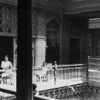Disclaimer
This entry contains information known to us from a variety of sources but may not include all the information currently available. Please be in touch if you notice any inadvertent mistakes in our presentation or have additional knowledge or sources to share. Thank you.
Archive
AIU Girls School at Baghdad, Iraq
The AIU Girls School (Laura Kadoorie: בי"ס אליאנס לבנות) in Baghdad (בגדד, بغدد), Iraq (עיראק, العراق).
Description
In 1893, the Laurie Kadoorie School for girls was established with an identical curriculum to the Alliance Israélite Universelle's Boys School which opened in 1864. The boys school had closed due to religious opposition, but reopened eight years later with the financial support of Sir Albert (Abdulla) David Sasson. In 1911 Eliezer Khaduri built a new building for the school in memory of his wife Laura.
The schools taught secular ideas which the Jewish rabbinate originally opposed, until Rabbi 'Abd Allāh Somekh sent his own sons to the boys school. During the 1930s and 40s, some of the AIU schools in Baghdad organized Hebrew literary societies which promoted Jewish nationalism and became linked to the Zionist movement. The AIU emphasized European languages, especially French, and modern sciences in their curriculum. The number of Jewish schools in Baghdad continued to grow to support over ten thousand students. In 1950 the Laura Kadoorie School had 1,388 students across all grades [1].
Baghdad was home to the largest Jewish community in Iraq possibly from as early as its founding in the eighth century. By 1908, the Jews of Baghdad numbered around 53,000, about a third of Baghdad's total population. Jews lived in many quarters including al-Tawrat, Tahat it-Takyah, Abu Saifan, and Suq Hannun. Although Jews were involved in local politics, new tensions began to rise between Jews and Muslims, leading to an anti-Jewish riot on October 15, 1908. World War I forced many Jews to flee the city. In 1948, the Jewish community in Baghdad numbered around 77,000, however the Jewish community began to fear life in Baghdad after the Farhūd. The Farhūd was a pogrom on June 1, 1941 that left 130 Jews dead and caused devastating property damage. The Farhūd inspired the growth of Zionism and Communism among a minority of Jews in Baghdad who felt increasingly disconnected from the Iraqi state. Bombings throughout the 1950s further estranged the Jewish community only about 6,000 Jews remained in Iraq by 1952 due to mass immigration to Israel, Europe, the United States and Canada. The Jewish community endured further violence throughout Saddam Husayn's regime, and in 2003 the last synagogue in Baghdad had closed [2][3].
Sources
[1] Gazala, D. "Girls' School of the Alliance Israélite Universelle, at Bagdad." JewishEncyclopedia.com. N.d. Accessed June 30, 2014, http://d5iam0kjo36nw.cloudfront.net/V02p437001.jpg.
[2] Yaron Ayalon; Ariel I. Ahram. "Baghdad." Encyclopedia of Jews in the Islamic World. Executive Editor Norman A. Stillman. Brill Online, 2014. Reference. Wellesley College. 19 June 2014 <http://referenceworks.brillonline.com/entries/encyclopedia-of-jews-in-the-islamic-world/baghdad-SIM_000468>.
[3] Dispersion & Liberation Album: Jewry of Iraq












